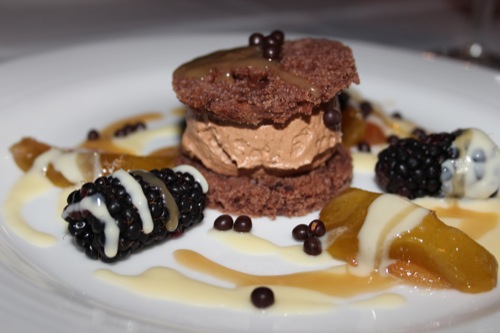
French pastry, by Eliza Myers
Inspiring Eyes
I stared at the downturned eyes of the Mary statue for a long time because they seemed right on the verge of looking up. But although I enjoyed the peaceful 1714 St. Marie Madeleine Chapel, I did not witness the eyes come to life, which Father Frederic reportedly saw in 1888. The miracle continues to inspire 250,000 people to travel to Our Lady of the Cape Shrine in Trois-Rivières annually.
“Father Frederic described Mary as looking far ahead with love and compassion,” said Father Yoland Ouellet, rector of the shrine. “He was so deeply touched by that miracle that he stayed here for 14 years. We say he has ‘the eyes that have seen the eyes.’ That says it all.”
Outside the chapel, I walked past the national shrine’s serene gardens and religious statues before entering the 1964 modern basilica. The interior of the church stretched so expansively that I could capture only small portions with my camera. The organ echoing across the basilica set the perfect mood for gazing at the church’s glowing stained-glass windows that took 10 years to make.
After leaving the basilica, I explored another national shrine that used its remote location to create a retreatlike atmosphere. St. Anthony’s Hermitage of Lac-Bouchette immediately impressed me with its quiet natural surroundings.
“Our motto at the hermitage is to welcome, to serve and to love,” said Father France Salesse, a Capuchin priest and a passionate guide at the hermitage. “Here you have a chance to see the nature and beauty of Quebec.”
The hermitage’s St. Anthony’s Messenger Dining Room served me French Canadian fare family-style so that I was able to try a bite of all of the tender meats and delicious sauces offered. The meal fortified me for my climb the next morning up to St. Anthony’s Observation Deck. At the top, I watched the sun’s rays slowly fall on the surrounding lake, forests and hermitage chapels.
Father Salesse met me on the ground for a tour of the hermitage’s attractions, including the site’s historic churches, museum, bell tower and grotto replicating the grotto in Lourdes, France.
Quebec City’s French Roots
A man wearing a dark cloak, boots and a hat from the 1600s described the grit needed for early French settlers starting a life in Quebec City. I leaned forward with fascination as he interpreted the character of Louis Hebert, the first settler of Quebec City.
“It was so rough in the beginning,” said my guide. “No one could make it through the winter here. Everyone would say to the boats coming to the city, ‘Good luck; we’re going back.’ I was the first one to come here and stay more than a year, which is why they call me the first settler.”
I followed my guide inside the thick stone walls surrounding Old Quebec, which is the only fortified city north of Mexico and a UNESCO World Heritage Site. French culture seems to permeate everything, including the narrow cobblestone streets, the historic churches and the brightly colored stone buildings bedecked with flowers.
I continued my tour to Quebec City’s Citadel, which is still an active military base, although it seems more like a tranquil park. This national historic site once played a vital role in the French and Indian War. My guide described how John Wolf defeated the French army by famously telling his men to wait until they saw the whites of the enemies’ eyes before firing. This pivotal battle is why Quebec became a British colony in 1763.
After my city tour, I learned to appreciate copper engravings on a whole new level at the Albert Gilles Copper Art Museum. The family-owned museum and store highlights the now rare copper engraving technique called repoussé.
“Repoussé is a dying art. That’s why I’m going to show you how it’s done,” said Palmyre Gilles, public relations manager for the Albert Gilles Copper Art Museum. “My father learned this art through a lot of practice. There were no iPods or video games of the day to distract him.”
Gilles demonstrated the process of using a tool to dent the copper into the desired shape. One mistake meant completely starting over.
After learning about the painstaking technique, I could better admire the exhibits and copper art pieces, which include a giant rooster, copper doors and religious scenes.









